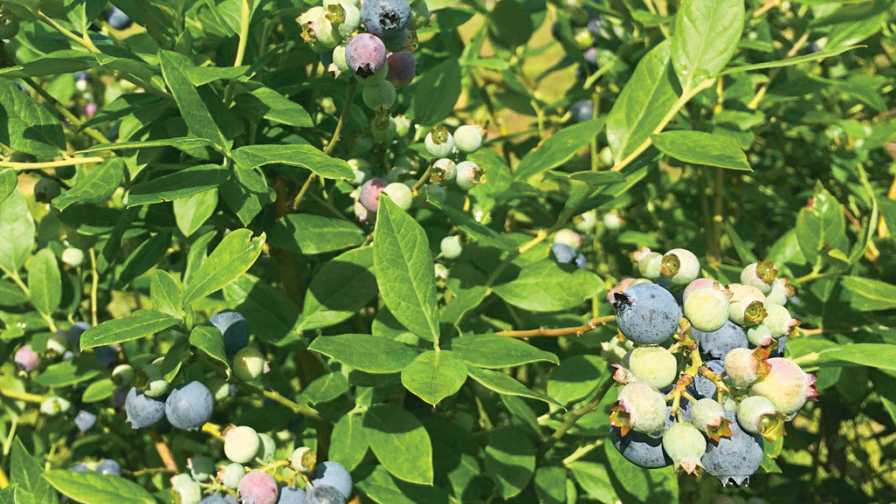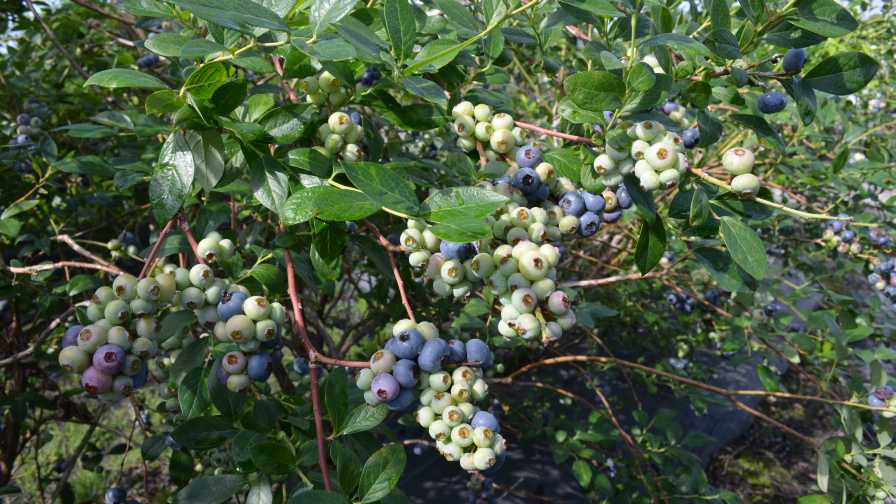Get a Look at New and Existing Florida Blueberry Varieties

‘Colossus’ is the latest blueberry variety release from UF/IFAS.
Photo courtesy of UF/IFAS
The University of Florida (UF) blueberry breeding program releases cultivars that can provide Florida producers an edge in the market. The program’s webpage has details of yield, timing, concentration, and fruit quality for most cultivars for the 2018 and 2019 seasons.
Here we will review the performance of known and recent releases, as well as introduce a new cultivar (‘Colossus’) that will be released this year.
The Big Boy
The cultivar ‘Colossus’ is the newest (2019) release from UF. In advanced selection trials, it has been later blooming with a short bloom to ripening period. It appears to perform better with low doses of hydrogen cyanamide and has performed well in North-Central and Central Florida trial sites. Fruit is very large to jumbo, very firm, and stores very well. Color is complete, with a small scar and good natural wax bloom.
During the 2019 season in Central Florida, ‘Colossus’ had 50% bloom by the end of January and 50% ripe fruit by the last week in March. The best fruit is obtained by allowing it to hang on the bush until the preferred sweet and acid balance is achieved. This cultivar is being recommended for Central and North-Central Florida under the deciduous system.
Optimus for Mechanical
Cultivars ‘Magnus,’ ‘Wayne,’ and ‘Optimus’ were 2017 UF releases. While more time is needed to complete a good assessment of these cultivars, we have observed a quick trend with ‘Optimus.’ It was released to specifically target machine harvesting. Its adoption has been rapid because it produces high yields with good timing for the Florida market window, with natural early leafing and firm, medium-sized, high-quality berries. It has shown good production across Florida under both deciduous and evergreen production systems and has performed well using machine harvesting.

In Central Florida in 2019, ‘Optimus’ had 50% bloom by the last week in January, and 50% of its fruit was ripe by the first week in April. During the summer of 2018, algal stem blotch was observed in this cultivar. Photo courtesy of UF/IFAS
Going Evergreen
In 2015, the UF blueberry breeding program released three cultivars targeting the evergreen production system used in Central and South-Central Florida. These cultivars are ‘Arcadia,’ ‘Avanti’, and ‘Endura.’ Here’s what we have been observing in terms of their performance the past few years.
Under the evergreen system, plants do not go dormant and retain their leaves through the fall and winter to support the next season’s early fruit harvest. ‘Arcadia’ is a very vigorous plant with very high yields, very low chilling requirements, and foliage that is tolerant of many leaf diseases. Tolerance of leaf disease is an important factor as the plant is producing fruit with the prior year’s leaves instead of the current year leaves like in the deciduous system.
This cultivar, if planted at the right time and maintained well, can have good fruit production in the first year after planting. In 2019 in South-Central Florida, it reached 50% bloom the last week in January, with 50% blue fruit the second week of April. However, the yield is not as concentrated as other cultivars. ‘Arcadia’ also has shown susceptibility to bacterial wilt (Ralstonia solanacearum), but the level of severity varies significantly from farm to farm.
‘Avanti’ can be grown in Central and some parts of North-Central Florida in a deciduous system, but with lower performance, so it is only recommended for the evergreen system. It has very low chilling requirements, above average yield potential, and early fruit maturity.
During the 2019 season in South-Central Florida, it achieved 50% bloom the last week of January, and had a 50% blue fruit crop by the second week in April. ‘Avanti’ has shown some susceptibility to spider mites and algal stem blotch, which will require good control programs. The fruit is very sweet and pleasant to eat.
‘Endura’ is a mid- to late-maturing variety in the evergreen production system. It can perform well under both evergreen and deciduous production systems. However, its harvest period can be later than other cultivars and very long under the evergreen system. In South-Central Florida in 2019, it reached 50% bloom the second week of February, and 50% blue fruit the last week of April.

‘Patrecia’ was developed by Florida blueberry pioneer Alto Straughn.
Photo by James Olmstead
Deciduous Duty
The cultivars ‘Keecrisp’ and ‘Patrecia’ were released by UF in 2016 for the deciduous system in North-Central Florida. ‘Keecrisp’ requires more chilling hours than we have experienced in the last few years, and thus is no longer recommended. ‘Patrecia’ is late blooming and early ripening and fits well in the Florida market window; however, it must be treated with hydrogen cyanamide in order to achieve good results. The fruit is large and firm, but the scar and tearing of the fruit could be a problem if not handled carefully. The plant canopy is sparse and lets lots of light into the interior of the bush.
Older Selections
Other cultivars still used and recommended for replanting in Central and South-Central Florida are ‘Chickadee’ and ‘Kestrel.’ Although their yield is not as high as newer cultivars, some producers are still making profits with them. ‘Emerald’ has been a pillar for the Florida blueberry industry. It is still a preferred cultivar by many producers in the central part of the state with high yields, although it can be mid-to-late season. ‘Farthing’ is a high-yielding cultivar that works best with hydrogen cyanamide and is still recommended for North-Central Florida.
While several producers still have cultivars such as ‘Jewel’ and ‘Springhigh,’ we no longer recommend them for planting or re-planting because fruit firmness and quality are not up to today’s market standards. Similar, while some producers have been very successful with the cultivar ‘Meadowlark,’ we no longer recommend it since its performance has been very erratic over the last few years due to different reasons.









